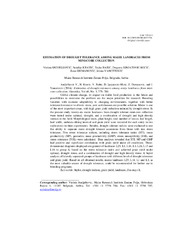Приказ основних података о документу
Estimation of drought tolerance among maize landraces from mini-core collection
| dc.creator | Anđelković, Violeta | |
| dc.creator | Kravić, Natalija | |
| dc.creator | Babić, Vojka | |
| dc.creator | Ignjatović-Micić, Dragana | |
| dc.creator | Dumanović, Zoran | |
| dc.creator | Vančetović, Jelena | |
| dc.date.accessioned | 2019-05-16T12:17:14Z | |
| dc.date.available | 2019-05-16T12:17:14Z | |
| dc.date.issued | 2014 | |
| dc.identifier.issn | 0534-0012 | |
| dc.identifier.uri | http://rik.mrizp.rs/handle/123456789/535 | |
| dc.description.abstract | Global climate change, its impact on stable food production in the future and possibilities to overcome the problem are the major priorities for research. Breeding varieties with increase adaptability to changing environments, together with better tolerance/resistance to abiotic stress, pest and diseases are possible solution. Maize is one of the most important crops, with high grain yield reduction induced by drought stress. In the present study twenty-six maize landraces from drought tolerant mini-core collection were tested under optimal, drought, and a combination of drought and high density stresses in the field. Morphological traits, plant height, total number of leaves, leaf length, leaf width, anthesis-silking interval and grain yield were recorded for each entry in two replications in three experiments. Besides, drought tolerant indices were evaluated to test the ability to separate more drought tolerant accessions from those with less stress tolerance. Five stress tolerance indices, including stress tolerance index (STI), mean productivity (MP), geometric mean productivity (GMP), stress susceptibility (SSI), and stress tolerance (TOL) were calculated. Data analyses revealed that STI, MP and GMP had positive and significant correlations with grain yield under all conditions. Three-dimensional diagrams displayed assignment of landraces L25, L1, L14, L3, L26, L15 and L16 to group A, based on the stress tolerance index and achieved grain yield under optimal, drought stress, and a combination of drought and high density stress. A biplot analysis efficiently separated groups of landraces with different level of drought tolerance and grain yield. Based on all obtained results, maize landraces L25, L14, L1 and L3, as the most valuable source of drought tolerance, could be recommended for further use in breeding programs. | en |
| dc.publisher | Društvo genetičara Srbije, Beograd | |
| dc.relation | info:eu-repo/grantAgreement/MESTD/Technological Development (TD or TR)/31028/RS// | |
| dc.rights | openAccess | |
| dc.rights.uri | https://creativecommons.org/licenses/by-nc-nd/4.0/ | |
| dc.source | Genetika | |
| dc.subject | biplot | en |
| dc.subject | drought indices | en |
| dc.subject | grain yield | en |
| dc.subject | landraces | en |
| dc.subject | Zea mays L. | en |
| dc.title | Estimation of drought tolerance among maize landraces from mini-core collection | en |
| dc.type | article | |
| dc.rights.license | BY-NC-ND | |
| dc.citation.volume | 46 | |
| dc.citation.issue | 3 | |
| dc.citation.spage | 775 | |
| dc.citation.epage | 788 | |
| dc.citation.other | 46(3): 775-788 | |
| dc.citation.rank | M23 | |
| dc.identifier.wos | 000348608200011 | |
| dc.identifier.doi | 10.2298/GENSR1403775A | |
| dc.identifier.scopus | 2-s2.0-84922208977 | |
| dc.identifier.fulltext | http://rik.mrizp.rs//bitstream/id/2469/533.pdf | |
| dc.type.version | publishedVersion |


